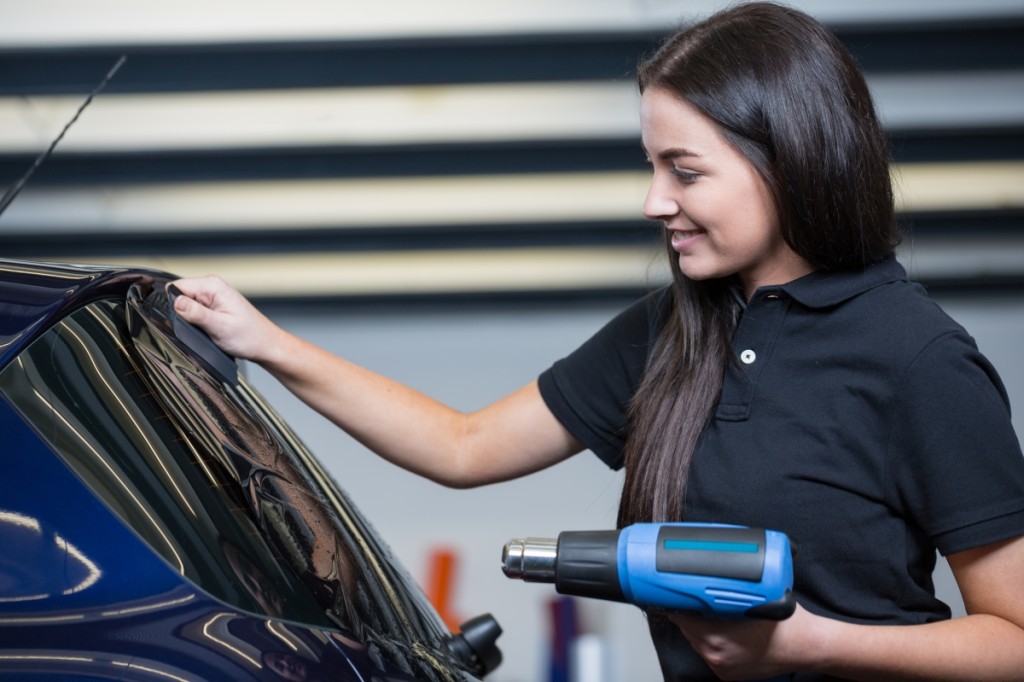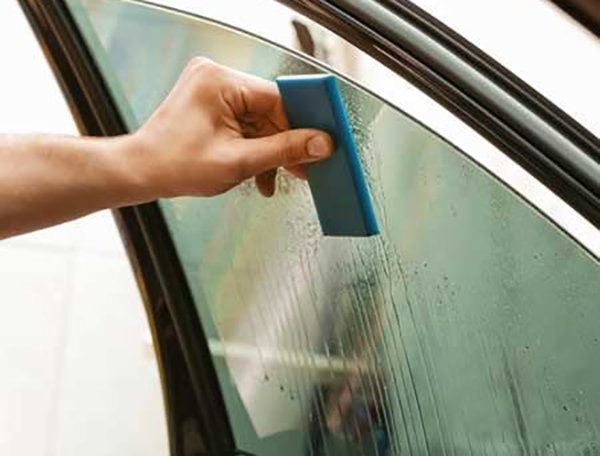There are many reasons for removing tint from car windows. Everyone has their own, and the consequences of withdrawal are the same. This is a fresh or dried glue with the remnants of a tinted coating.
Let’s get straight to the point. At the same time, we will consider the accompanying points: what mistakes and unexpected surprises can be when cleaning the glue from tinting.

Photo: wcmanet.org/
What is toning
To give solidity to the exterior of the car, the owners stick a tint film on the glass. Someone does it on their own: they order material on websites and glue it in the garage. So much cheaper and the result is not bad. Someone applies for a service to the service.
Glue composition
In order for the film to hold for a long time, not to leave at the edges, glue based on acrylic polymers is used for its production. Depending on the thickness of the film, the adhesive can remain tacky for 1 to 4.5 months.
Over time, the adhesive hardens and dries. This feature determines the subtleties of removing the old and fresh coating.
Glass features
We will remove the film from the glass. It is important for the poem to understand the properties of this material and its resistance to various substances and physical influences.
Glass refers to inert materials that do not enter into most chemical reactions. This suggests that solvents for polymers cannot harm him.
At the same time, glass has a sufficiently high degree of rigidity, and it can only be damaged by harder objects or abrasive. These include substances containing metallic abrasive, feldspar, quartz, corundum, topaz and diamond.
However, car owners should not forget that factory tinted windows are often applied to the windows. It can quickly give the glass a haze if rubbed with a thinner or something hard. At this point, you need to pay attention. because often the production tinting is not noticeable. It only gives the glass a slight tint.
A feature of the rear window of the car is the presence of heating threads. Therefore, in order to avoid damage to them, we strongly do not recommend using rough physical methods to remove the film and glue.
Film removal methods
If you already have a problem in the form of a layer of dried glue, you can immediately skip to the next section.
If there is a film coating, we will try to remove it simultaneously with the glue. If the result is unsuccessful, we will remove the remnants of the adhesive layer with improvised and specialized means.
Heat

Photo: windowfilm24.eu/
The acrylic composition acquires its former softness if it is well warmed up. Therefore, we arm ourselves with something that can produce a stream of warm air.
It could be:
-
Construction hot air gun.
-
Household hair dryer.
-
Thermal fan.
To soften the adhesive, you need to direct a stream of air onto the glass, and allow the surface to heat up evenly. The airflow temperature should be 40 degrees Celsius. This is enough to remove the film and avoid damage to the plastic.
Further, without stopping the supply of warm air, we will do this:
-
We pry the upper corner of the film with a sharp object, take it with our fingers and begin to slowly pull.
-
We pull and at the same time heat the area where the film leaves the glass with a hair dryer.
-
The same must be done on the other side.
-
We evenly and slowly pull the film towards ourselves, now from one corner, then from the other.
-
We completely remove the tint coating.
This method is applicable for both side and rear windows.
When removing the cover from the rear window, we recommend not to rush. The more successfully the tinting coating is removed along with the adhesive, the less likely it is that the heating filaments will be damaged during further removal of adhesive contamination residues.
The ideal option is when the tint is gone completely, leaving no sticky marks behind.
Mechanical removal
Simply peeling off the film without heat should also be done slowly, without fuss. This will save you from the tedious work of erasing the glue.
First of all, you need to pry off the edge of the film. Don’t let it break. Try to shoot in one piece. If there is a break in the corner, pry the tint on the other side and pull it so that the break remains in the center. Then, joining the edges, pull the entire sheet.
If the film is not old, it can be removed quite easily. But depending on the quality of the coating, the adhesive can either come off completely, leaving only small spots, or remain completely on the glass.
Methods for erasing glue
It happens that the old PVC coating begins to crumble. You have to remove small fragments, and all the glue remains on the glass. In this case, the work is delayed, and additional glass cleaning products are required.
The side windows are a little easier. Most often it is a flat surface without foreign elements. First, let’s try to remove the glue with what is at hand.
improvised means

Photo: gangstawindowtinting.com/
To clean small areas, you can use blades or special scrapers with a sharp surface. Metal objects should not have notches so as not to scratch the glass.
Mechanical cleaning of side windows
We recommend this method for the side windows of the car. Since, as mentioned, the rear panoramic glass has heating threads glued on, which are easy to damage.
To remove the remnants of the film and glue, you need to cook the following tools:
-
Special construction scraper with a blade.
-
Replacement blades for a construction knife and pliers.
-
Construction tape or duct tape.
-
Water-soap solution (2–3 drops of liquid soap per 500 ml of water).
-
Sponge for washing dishes.
If there is no special scraper, we will make a device with our own hands. To do this, break off half of the new blade for a construction knife and seal the blunt part along with 2–3 layers of masking tape or electrical tape. This technique will allow you to more securely hold the blade in the pliers.
Sequencing:
-
You need to clean the glass from top to bottom, placing the tip of the tool at an angle of about 30 degrees. The adhesive surface does not need to be wetted.
-
After removing most of the contamination, prepare a soapy solution, pour it into a spray bottle and moisten the glass.
-
After 2–3 minutes, carefully rub the remaining glue with a sponge. More difficult pollution again to clean a scraper.
-
When cleaning the glue near the skin, you need to take the blade in your hand and very carefully scrape off the layer with a sharp angle, slightly moving the tip under the seals.
-
Finally wipe the glass with a clean cloth.
Emulsion for removing tint without a hair dryer
We recommend using this method for the rear window. If it is not possible to provide heating with a hairdryer, you can use the following chemical method.
Let’s prepare the emulsion:
-
For 1 part water, take 1 part gasoline, 1 part solvent and 3 parts liquid soap.
-
Let’s mix the components.
-
Pour the mixture into a spray bottle and shake the bottle very carefully several times so that the composition becomes white.
This mixture has the following characteristics: active ingredients in the form of gasoline and solvent destroy the adhesive, and soap and water prolong the action of the composition, preventing it from drying out.
In addition to the working emulsion, you will need to work:
-
Film and textile fabric for covering plastic parts of the interior.
-
Foam sponges with a fiber layer.
-
Textile napkins.
-
Plastic scraper.
Processing sequence:
-
We close the surface of the plastic parts with a film and a cloth.
-
Before applying the emulsion, shake the can well and spray the product onto the glass.
-
We leave for 5 minutes. When the composition drains, we process it again.
-
With a plastic spatula, we begin to remove the softened glue.
-
After cleaning the entire surface, apply the suspension again.
-
Now, with an abrasive fiber of a regular foam rubber sponge, carefully wipe off the remaining glue. If the sponge is clogged, change to a new one.
-
We clean the glass again with a plastic spatula.
-
If necessary, repeat the treatment with a sponge.
-
We remove the remnants of the product with a rubber water separator.
-
1 We apply a soapy solution to the glass and remove it again with water.
-
1 Wipe the treated surface with a clean cloth.
Household solvents
We draw your attention to the fact that when working with chemicals, caustic fumes are released that are harmful to health. There is also a high probability of solvent damage to plastic parts.
To begin with, we list the funds that are sold in hardware, hardware stores and pharmacies:
-
Acetone. The paint thinner also dissolves the remnants of sticky stains well. Safe for glass.
-
Alcohol. Technical or medical alcohol does not damage the glass, but decomposes the adhesive.
-
Petrol. Like a solvent, it can damage plastic decor, but is much less aggressive. Inert to glass.
-
Formic alcohol and Dimexide are sold in pharmacies. These products dissolve the adhesive very actively and are safe for plastic parts.
-
Antisilicone. General purpose solvent. It is used by motorists to get rid of all sorts of stains.
All of these substances are volatile and evaporate quickly. Therefore, the use of liquid will be more effective if you make a kind of compress out of them. If the spots are small, moistened cotton pads can be applied. With a large area of contamination, you can moisten a cloth with a solution.
After 5 minutes, apply a soapy solution to the entire surface to be cleaned and then begin to clean off the swollen glue. This can be done with a knife, a metal or plastic scraper, or the hard side of a dish sponge.
Special squads
Specially developed agents against traces of glue are highly effective. Different price ranges allow you to choose the best option.
Here is a list of cleaners for tinting and glue:
-
Turtle Wax Clear Vue Glass Clean. It has a complex composition that eliminates many types of persistent technical stains. The average price is 4 dollars. for 500 ml. -
Profoam 2000. Copes with different types of adhesive coating and many other complex technical dirt. The average price for a 600 ml spray bottle is 2,5 dollars. -
Body cleaner AVS Antiscotch. Liquid in a can under pressure, 0.21 l. The average cost is 2,5 dollars. -
DONEDEAL. 150 ml mechanical spray bottle. It is sprayed on the surface of contamination and removed with a napkin. Price — 2 dollars. -
Citosol. Safe for glass. The composition includes natural ingredients that easily remove glue. The cost of a 200 ml can is 2 dollars. -
KERRY 520 ml. The tint cleaner has a gel consistency that facilitates easy application and quick dissolution of adhesive residue.
These and similar tools can be used to save time and get quick, high-quality results. For each individual case, you can choose the best solution for the price.
Removing tint is a simple task. At the same time, the process requires accuracy and patience. The proposed improvised and industrial tools will help solve the problem with glue residue on the glass.

Добавить комментарий
Для отправки комментария вам необходимо авторизоваться.